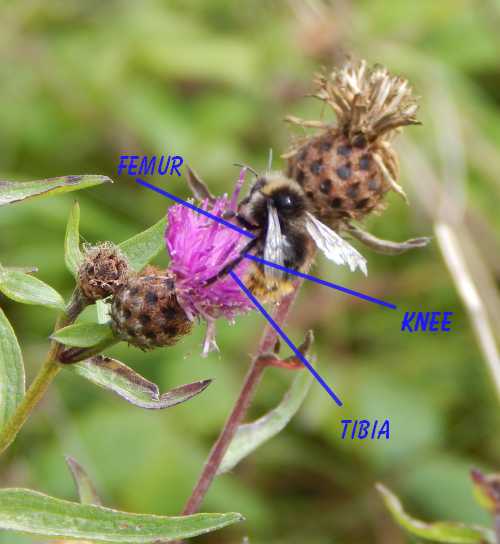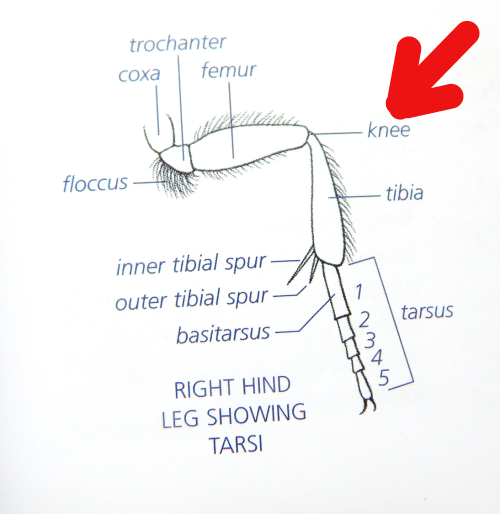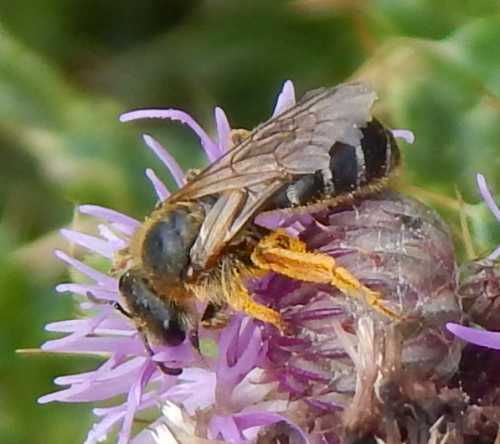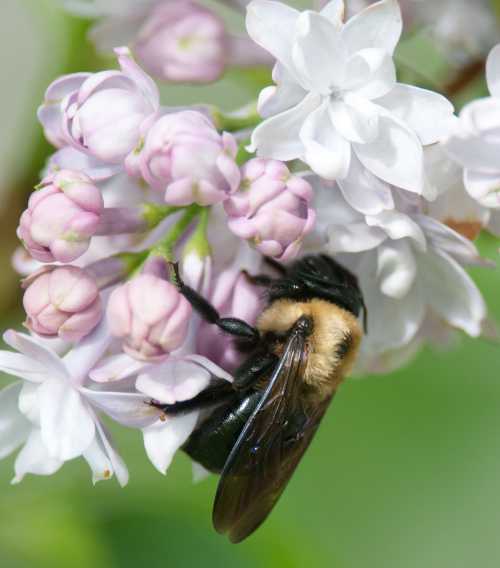Do Bees Have Knees?
We've all heard of the phrase 'the bees' knees'. If something is 'the bees' knees' then it must be good. But do bees have knees - really?
The short answer is:
YES! Here is an explanation and diagram showing the anatomy of a bee's leg, with the knee clearly labelled.
So how do we know that bees have knees?
Firstly, what is a knee?
If we want to know whether or not bees have knees, we need to define exactly what a knee actually is.
Here is a definition from The American Heritage® Medical Dictionary (the third definition being especially pertinent here):
knee (nē)
n.
1. a. The joint between the thigh and the lower leg, formed by the articulation of the femur and the tibia and covered anteriorly by the patella.
b. The region of the leg that encloses and supports this joint.
2. An analogous joint or part of a leg of a quadruped vertebrate.
3. The joint between the femur and the tibia in an insect leg.
From: The American Heritage® Medical Dictionary Copyright © 2007, 2004 by Houghton Mifflin Company.
Given that bees have both a femur and a tibia, it can therefore be stated that bees really do have knees!
 Here you can see the labelled parts of the bumble bee leg.
Here you can see the labelled parts of the bumble bee leg.It's interesting, however, that few diagrams of bee anatomy actually label the knee, but I eventually found one.
It comes from entomologist, Steven Falk's Field Guide to Bees Of Great Britain And Ireland in the section of the book titled Bee Anatomy.
 Above: 'Diagram of the right leg of a bee, showing tarsi' - and with knee labelled!
Above: 'Diagram of the right leg of a bee, showing tarsi' - and with knee labelled! From Falk's Bees Of Great Britain And Ireland.
You can see that the leg of a bee is segmented, and those segments include
- the femur and the tibia
- the other sections of the leg being the coxa, trochanter, basitarsus and tarsus.
Do the bees' knees have a special function?
The three pairs of legs on a bee have distinct features, that sometimes vary, depending on the species.
For example:
- On the tibia of each hind leg, bees have special hairs that they use for cleaning their wings.
- Many bee species have 'brushes' and 'combs' on the middle legs too, and these are used for scraping pollen to the hind legs.
- Bees such as bumble bees and honey bees have pollen baskets on their hind legs, known as corbiculae. You can read more about this on my page How Do Bees Collect Pollen?
- In oil-collecting bees such as Centris, the bees use long hairs on their front and middle legs (that actually look like butter knives or spatulas), to scrape up the floral oil from the flower. These bees then store the oil in the scopae (tufts of pollen-collecting hairs on the hind legs) to take back to their nests.
However, it seems the bees' knees themselves perform no special function.
What Is The Origin Of The Phrase 'The Bee's Knees'?
‘The bee’s knees’ is a well-known phrase, but what is the origin?
Nowadays we consider the term to mean something excellent or very good, but it appears it may not always have had this meaning.
The Oxford English Dictionary states that as far back as 1797, the expression ‘bee’s knee’ was used in Britain to mean something small or insignificant.
Some say that the expression originated from “B’s and E’s” – meaning “the be-all and end-all” which, it is said is an allusion to Shakespeare’s use of the expression in Macbeth from 1605.
But I'm personally not convinced. Today we generally use the expression ‘be all and end all’ to suggest that something is not the only thing that matters, or even more casually it is used to hint that ‘the sky is not about to fall in’.
However, real evidence for its early use as an expression dates back to a spoof report from August 1906, in the West Coast Times in New Zealand. The paper reported that within the cargo carried by the SS Zealandia, there were 7 cases of ‘bees knees’, along with a ‘quantity of post holes’.
The expression was thus used as a means of deliberately misleading and befuddling someone, a little like asking a person to fetch striped paint or a sky hook.
Even so, why the use of the expression in a particular context should have evolved to have an entirely different meaning, is not clear.
The expression ‘the bee’s knees’ became popular in the USA in the 1920s, and some suggest that its use is an allusion to the World Champion Charleston dancer Bee Jackson – hence ‘Bee’s knees’! Could this be the point at which the term began to be associated with 'excellence'?
After all, the 1920s was a period of time when other such expressions in the USA became popular, such as: 'the cat’s pyjamas'.
Did you know?
The 'Bee’s Knees cocktail' is a drink that originated in the USA during the prohibition era between 1920 and 1933 (the prohibition was the ban on production, importation and sale of alcoholic beverages in the US).
It is thought that the cocktail was invented as a means of masking the poor smell and harsh taste of homemade gin (sometimes called ‘bathtub gin’) that was made as a means of circumventing the prohibition laws, and that occurred as a result of using poor quality grain alcohol.
If you found this page helpful or interesting, I'd really be grateful if you would share it with others - if not this page, perhaps another, such as Gardening For Bees.
Thank you so much :) .

